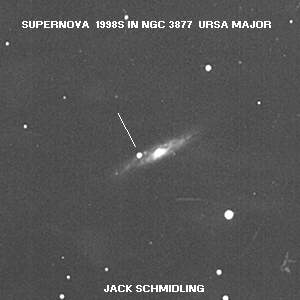| Extragalactic Photos | Galactic Photos | JSP Homepage |

The star is "bright" only in relative terms as it takes a respectable telescope to even
see it. However, as the galaxy is so far away that no other star in it can ever be seen
with any telescope, just seeing it is big news.
I said the event "took place" this year but actually it happened millions of years ago and even traveling at the speed of light (186,000 miles per second) we didn't know it happened until the light got here and that was in March of this year.
Although supernovae are the biggest things that can happen in the universe since the Big Bang, they are not all that rare on the cosmic scale. Any given galaxy might have a couple every thousand years or so and as there are millions of galaxies within reach of our telescopes, we can see several each year.
The good news is that there has never been one anywhere near our location in our galaxy (the Milky Way) and we are therefore still around to marvel at them. Although 4 have been witnessed and recorded in the past thousand years, not a single one has appeared in our galaxy since the invention of the telescope.
To see an example of a recent near miss go to:
Crab Supernova Remnant
Technical Details of photo:
This was a 30 minute exposure on hypered Techpan taken with the 16" Newt.